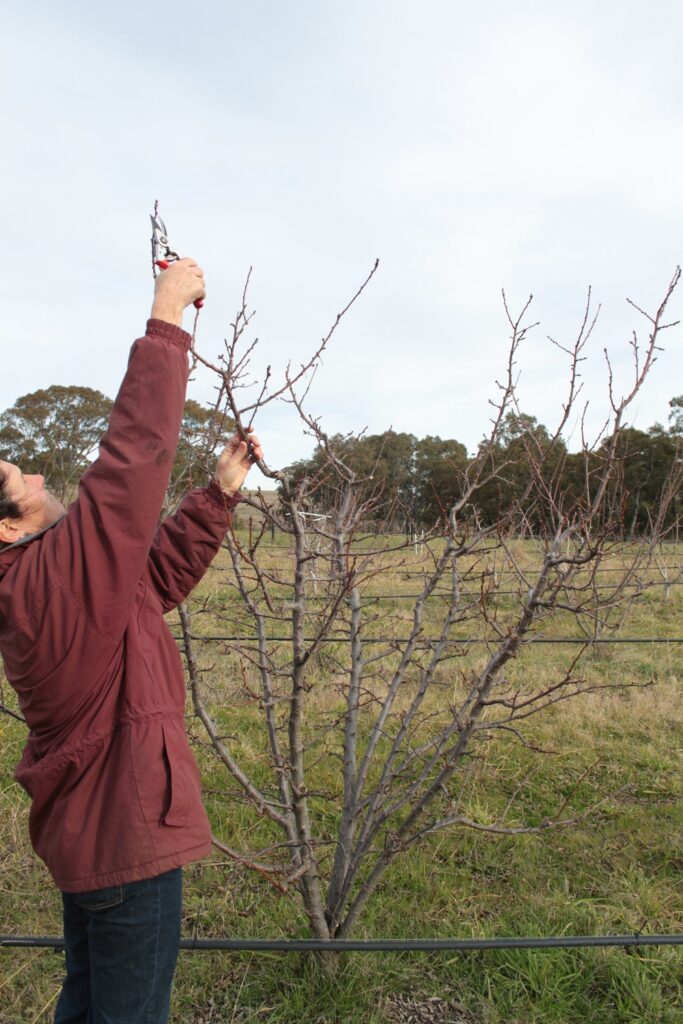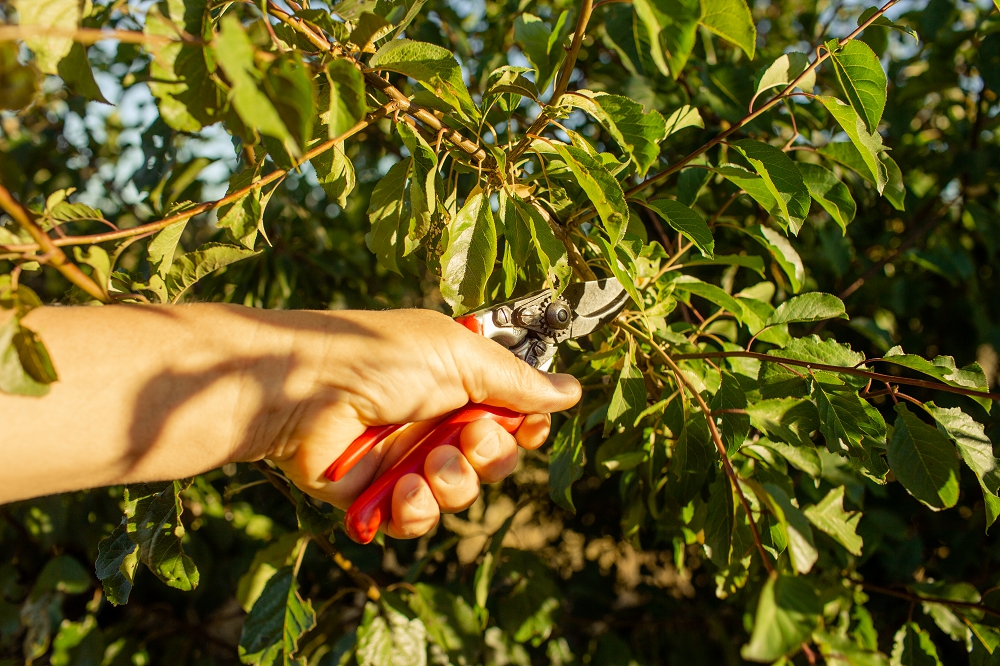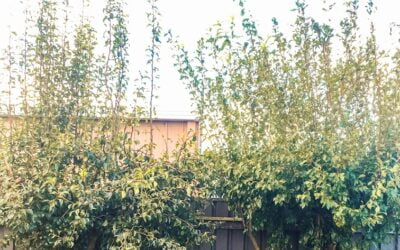Estimated reading time: 5 minutes
Have you started your winter pruning? If the leaves have fallen off your apple, pear, plum, peach, or nectarine trees (or any deciduous fruit or nut trees), now’s the time to get started.
We talk a lot about pruning because we know it worries more than 50% of home growers, which is why we developed our foolproof 7-step pruning method.
Understanding the parts of your fruit tree
Before you get started with learning how to prune, it’s fairly important to understand the different parts of your tree and what they do. So we thought we’d share some basic pruning terminology.
Here’s how we label various parts of the tree:

Limbs and branches in fruit trees are sometimes called ‘scaffold’ branches
These are the permanent, structural parts of your fruit tree. We usually recommend pruning your trees into a ‘vase’ shape, with between 6 and 10 limbs, starting from a central point about knee height above the ground.
The photo above is a young plum tree that only has 4 limbs, but has been pruned back hard to encourage more limbs to grow from low in the tree. This technique is called ‘establishment pruning’, and is absolutely crucial to creating a useful shape for your tree right from the start.
Of course, your tree may have a different shape, e.g., espalier, central leader, or more of a wild and possibly completely unpruned shape (those last ones are pretty common!).
Fruit tree laterals (side-branches)
These are shorter pieces of wood, also called small branches, side branches, shoots or twigs, that grow from the limbs. These are the main fruit-bearing parts of the tree.
Strictly speaking, a lateral refers to one-year-old wood, i.e., the shoots that grew in the summer just gone. To keep things simple, we use the word ‘lateral’ to refer to any growth coming from a limb.
A lateral itself may have side shoots, which can be a useful place to shorten the lateral back to.

Fruit tree spurs
A spur is a collection of buds, mainly fruit buds but also leaf buds, on a lateral. Some of these buds may turn into new shoots. The older a spur is, the less likely it is to generate new shoots.
Some fruit trees are much more prone to developing spurs than others, e.g., pears, some apples, and some plums. Apricots can also form spurs. The spurs can keep bearing fruit for years and require little pruning. If they are getting too crowded, it’s OK to do some ‘spur pruning’ to thin them out a bit.

Buds on fruit trees—two types
Fruit trees have fruit buds (which turn into flowers) and leaf buds (which turn into leaves and shoots). They can also have multiple buds that are a combination of the two.
Fruit buds tend to be fatter and a little furrier looking, and leaf buds tend to be flatter and less significant. This will look a little different on different types of trees, for example, it’s really easy to spot the difference on peach and nectarine trees, but can be harder on pears.
It doesn’t really matter if you can tell the difference because the tree’s got it sorted. However, it will add to your knowledge and is a really useful way of making sure you’re not accidentally cutting off all the fruit buds when you’re pruning.
So before you start, have a close look all over the tree to see if you can identify different-looking buds.
Understanding which part of the tree we’re talking about in our blogs and courses makes learning how to prune much easier. Next time you’re gazing lovingly at your fruit tree, make sure you can identify all its different bits!
Related Articles
Taming monster fruit trees with renovation pruning
Learn how to use a technique called renovation pruning to tame large, unpruned, and out-of-control monster fruit trees.
How to plant a fruit tree – the easy way
Everything you need to know about how to plant your new fruit trees to get them off to a great start in life.
What broke my fruit tree?
Broken fruit trees can be caused by animals eating them, or accidental damage. Identifying the animal is the first step to prevention.








very useful article. I may have been pruning away all the fruit buds!!
One thing I’m not certain of, how to tell the difference btwn the swelling bud (leaf or fruit) to disease? Like the swelling on a citrus, that must be cut away.
Hi Silvana, good question. A “bud” is a clear and distinct part of the tree, growing on top of the bark, whereas swelling from disease will look like an indistinct bump under the bark.
Hi Guys..I have a 3 way pear tree ready to prune but not sure which limbs have the grafts. The tree was @6 foot when bought it in summer and is thriving. It doesn’t need a lot of has pruning..should I leave it till it starts producing fruit? Cheers Karen
Hey Karen, no it’s best to prune pear trees in winter before they have leaves on them, but if it doesn’t need much pruning there won’t be much to do, as long as the “establishment pruning” phase is finished, and the tree has enough branches in it. You might be able to tell which variety is on which limb in the tree as you go through the season, because the leaves may come out at different times, it might flower at different times etc.
Hi, I have always pruned my fruit trees in winter, but recently went to a Pruning Day which said the best time to prune is after fruiting, summer/early autumn.
Theory was, flowing sap will heal cut areas and lessen disease over the wet winter months with winter pruning. Also discourage the tall vertical growth of non fruiting branches which occur in Spring.
What are your thoughts. Located Sth Inland NSW
Hi Heather,
Our approach to pruning always starts with a set of principles. We tend to steer clear of some of the pruning adages, as it really does depend on what type of tree & a whole lot of other factors. The key things to remember are that generally, pruning in summer will slow growth, pruning in winter will promote growth. Many stonefruit definitely benefit from a late summer prune, and that can really help with managing fungal diseases and promoting healing. The key principles we use are outlined over here in this blog if you want to read more. Thanks – Meg, Grow Great Fruit team.
Hi all,
I have 4 different types of plum and a mulberry growing in pots which were bare rooted and hard pruned when purchased (3 ft sticks). They bore no fruit over our recent spring/summer – I think due to the hard pruning but grew lots of leaves and branches. The new branches however are all very long and grow straight upwards (a few with minor laterals).
How do I tell which branches and how hard to prune in the coming winter in this instance please?
Hi Carina, while the trees are young the emphasis is on pruning hard with a purpose, which is to get the tree to grow branches in the right spots to make up the permanent scaffold of the tree. It’s called ‘establishment pruning’. It’s much more important to do that, rather than let the tree put its energy into growing fruit in the first few years (or until you have enough of those new branches). So, the question of whether you prune hard again or not depends on (a) what shape you want for the tree, e.g. vase, or espalier, and (b) how many branches you have at the moment, and whether they’re in the right spot for your intended shape, e.g. for a ‘vase’ shaped tree we recommend between 6-10 branches, evenly spaced around an open centre. We highly recommend learning how to do this technique because if you get the tree established well, it makes pruning SO much simpler for the rest of the tree’s life. We have a little short course on it: https://growgreatfruit.com/product/pruning-young-fruit-trees/
I have had 4 blueberry plants growing for 3 years & have only ever had about 6 blueberries of one of the plants. I have supplemented the soil with a garden acid mix & have used pine mulch as recommended by our local nursery. They also ph tested the soil & said it was the right ph. What else can I try to improve the plants & how do I prune these blueberry plants?
Hi Sharon, a key thing to observe is whether your plants are actually blossoming. I.e. if they are, and then not setting fruit, that’s one thing. If they are not flowering at all, that’s another. If it’s the latter, there could be a few reasons – such as sunlight (they can tolerate shade but do need sunshine to flower), drainage (don’t love being sodden), pollination (are there any different varieties of blueberry plants nearby and flowering at the same time). As for pruning, blueberries are a shrub rather than a tree, but our general pruning principles apply – you can read about them over here – Thanks – Meg, Grow Great Fruit team.
To keep leaf curl in check I read that you need to spray before bud swell. Does this means before leaves appear or before flower buds swell? Or are both leaves and flower buds considered the same for the purpose of spraying control?
Hi Jenny, leaf curl spraying is best done at first sign of budswell, which is well before leaves start to appear. A follow up spray 7-10 later is needed, and this is still well before there’s any leaves.